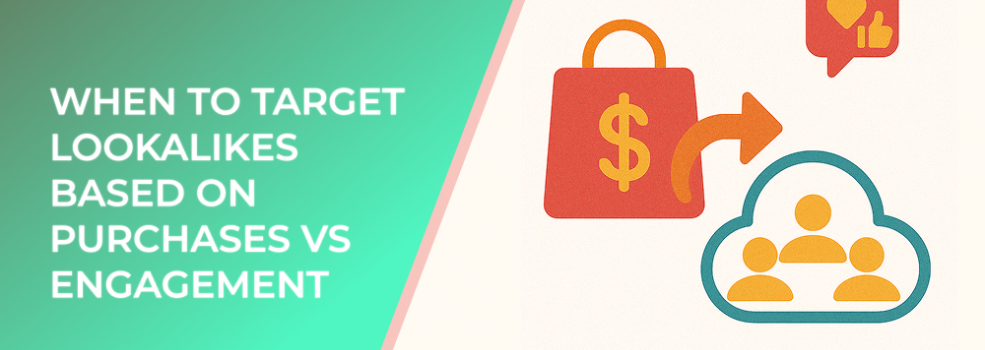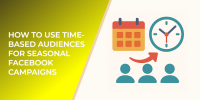Lookalike performance depends on what you teach the model. If you seed with Purchases, you train toward buyers and margin—but you need enough volume. If you seed with Engagement, you can scale faster with weaker signals. The right choice changes with your data velocity, funnel maturity, and objective. This guide breaks down when to favor each approach and how to switch as you grow.
Quick Verdict
-
Choose Purchase‑based lookalikes when you can sustain ≥ 50–100 purchases/week per geo on your optimization event and have a seed of 5k–20k recent buyers (preferably 0–30 day or 0–60 day window).
-
Choose Engagement‑based lookalikes when purchase volume is thin, launches are brand‑new, or AOV is high and the learning signal is scarce. Use high‑quality engagement (e.g., 25–95% video viewers, high‑intent engagers) rather than generic profile engagers.
Useful Stats & Guardrails
-
Well‑built purchase‑seeded LALs often deliver 10–25% lower CPA than engagement LALs at steady spend when volume is adequate.
-
Seed size sweet spot: 5k–20k people. Smaller than 500–1k is volatile; larger than 50k tends to dilute.
-
Recency matters: seeds with ≥ 60% added in last 60 days outperform stale seeds; monthly refresh keeps results stable.
-
Multi‑identifier uploads (email + phone) commonly add +8–20 percentage‑points to match rate, increasing the quality of downstream lookalikes.
-
Expect CPA to rise 15–40% as you expand from 1–3% lookalike tiers to 5–10%; treat higher tiers as scale levers, not replacements.
When to Target Purchase‑Based Lookalikes
Best for: proven products, clear attribution, and healthy conversion flow.
Signals you’re ready
-
You consistently hit learning volume (≥ 50–100 purchases/week).
-
You can build a clean buyers list with recent converters and exclude refunders/one‑and‑done promo buyers.
-
Your AOV or LTV varies meaningfully; you can seed with high‑value buyers (top quartile) to push model quality.
How to build
-
Start with 0–30 day buyers (or 0–60 if needed) and deduplicate; keep freshest consent timestamps.
-
Create 1% LAL per geo; expand to 2–3% and then 5–10% only if CPA holds within ±15% of target.
-
Refresh seed monthly (weekly at scale) and test a high‑value buyer seed (top 25% LTV) against “all buyers.”
Typical outcomes
-
Lower CPA, stronger down‑funnel conversion rate, smaller but higher‑quality reach.
When to Target Engagement‑Based Lookalikes
Best for: new brands, launch phases, content‑led products, or geos with thin purchase data.
Quality engagement cohorts
-
Video viewers at 50–95% completion (exclude low‑quality 3‑second views).
-
High‑intent engagers: profile visitors who messaged, saved, or shared; people who viewed product or spent ≥ 10s on site.
-
Add‑to‑cart or initiate checkout audiences when purchases are low.
How to build
-
Aggregate last 30–60 days of high‑intent engagement; target 5k–20k seed.
-
Launch 1% and 2–3% tiers first; cap frequency ≤ 6–8/7 days and rotate 3–5 concepts to curb curiosity clicks.
-
Promote to purchase‑seeded LALs once you hit the learning threshold.
Typical outcomes
-
Faster scale, broader reach, sometimes higher CTR, but higher CPA and more variance than purchase‑seeded LALs.
Switching Strategy: From Engagement to Purchases
-
Track weekly purchases from all paid + organic sources; once you sustain ≥ 50/week, begin building a buyers seed.
-
Run head‑to‑head tests: Engagement LAL vs 0–30 day Buyers LAL (1% tiers, same creative, same bid strategy).
-
If buyers LAL delivers CPA ≤ target for 2+ weeks and CTR/Hold Rate are stable, shift 30–70% of prospecting budget toward buyers LALs. Keep Engagement LALs as a scale flank or top‑of‑funnel reach driver.
Creative Considerations
-
Engagement LALs respond to curiosity hooks and bold storytelling; ensure landing pages filter intent quickly to protect CVR.
-
Purchase LALs benefit from proof‑heavy edits (UGC testimonials, demos, reviews) and clear pricing.
-
Maintain 3–5 active concepts; rotate weekly during scale and when frequency rises.
Measurement Checklist (copy/paste)
-
Seed size 5k–20k; ≥ 60% added in last 60 days
-
Multi‑identifier match rate uplift observed (email + phone)
-
1% tier performing within ±15% of CPA target
-
Expansion to 2–3% holds CPA; 5–10% used only when scaling
-
Purchase volume ≥ 50–100/week before prioritizing buyers LALs
-
Weekly seed refresh and exclusion sync verified
LeadEnforce Workflow
-
Unify data sources (CRM, checkout, site events) and apply audience hygiene (normalize, deduplicate, SHA‑256 hash).
-
Build distinct seeds:
Buyers_0‑30d,HighLTV_Buyers,HighIntent_Engagers_30‑60d. -
Generate LAL tiers per geo (1%, 2–3%, 5–10%) and label by seed + date.
-
Automate monthly seed rebuilds (weekly for high‑velocity) and daily suppressions for recent buyers/refunds.
-
Monitor CPA, ROAS, frequency, and seed recency mix in a weekly dashboard.
30/60/90‑Day Plan
Days 0–30
-
Launch Engagement LALs (1%, 2–3%) while seeding purchase data.
-
Target ≥ 100 qualified leads/month or ≥ 50 purchases/week milestones.
Days 31–60
-
Spin up 0–30 day Buyers LAL (1%) and test vs Engagement LAL.
-
If CPA wins, expand buyers LAL to 2–3%; keep Engagement LAL as reach extender.
Days 61–90
-
Introduce High‑LTV Buyers LAL and value/ROAS bidding.
-
Institutionalize monthly seed refresh; document expansion rules.
Troubleshooting
-
Low delivery: seed too small; widen recency window to 0–60/90 days or add identifiers (phone).
-
High CPA on Engagement LALs: tighten to high‑intent cohorts (95% video viewers, ATC) and improve landing specificity.
-
Buyers LAL underperforms: seed may be mixed—exclude promo buyers/refunds; test High‑LTV subset.
Suggested Reads from the LeadEnforce Blog
-
Lookalike Audiences: How to Seed, Train, and Scale
-
Audience Hygiene 101: Formatting, Hashing, and Deduplication Best Practices
-
Retargeting Without Waste: Exclusions, Frequency Caps, and Creative Rotation
Takeaway
Use Engagement‑based lookalikes to unlock reach when you lack buyer volume or during launches. As soon as you hit sustainable purchase volume, graduate to Purchase‑based lookalikes for more efficient CPAs and clearer profit alignment. With LeadEnforce, you can keep seeds clean, refresh on schedule, and scale lookalike tiers methodically across geos and budgets.

